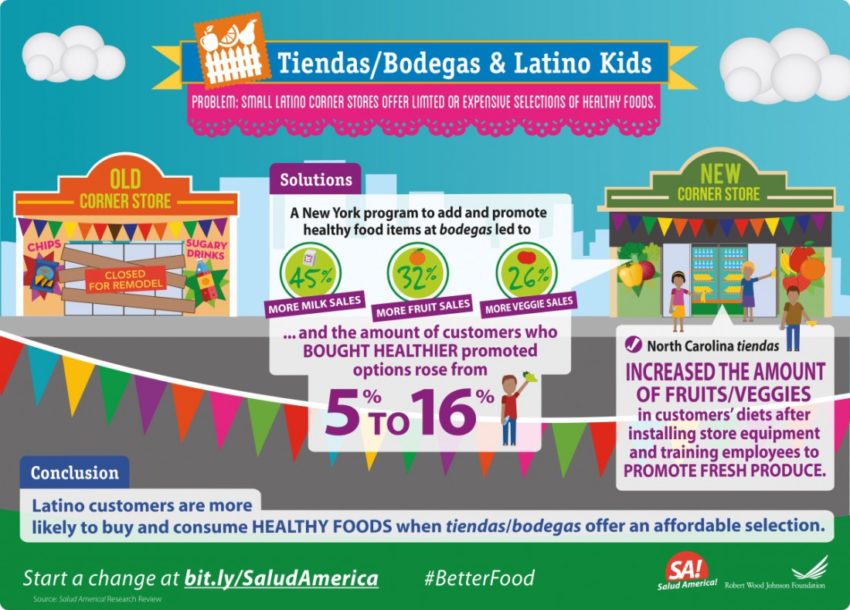
Share On Social!
This is part of our Food and Latino Kids: A Research Review »
Efforts rising to boost healthy food in corner stores
Initial findings on the impact of initiatives aimed at expanding healthy foods in corner stores have been generally favorable, although most studies to date are not large and rigorous in their methods and analyses.
Additionally, the majority of studies have not been conducted in areas with significant Latino populations.
Two reviews of several studies on corner store initiatives in areas with small numbers of Latinos found that most stores reported that the interventions were linked to increased sales of promoted healthy foods, including fruits and vegetables, low-fat milk, high-fiber cereals, and water.71,72
A small, randomized, controlled study of tiendas in North Carolina that predominantly served recent arrivals from Mexico and Central America found a moderate increase in the amounts of fruits and vegetables in customers’ diets four months after owners installed store equipment and trained employees and managers to promote fresh fruits and vegetables.73
The Healthy Bodega Initiative in New York City, which has a large proportion of Latinos, recruited more than 1,000 bodegas to increase their offerings of low-fat milk and fruits and vegetables and provided promotional and educational materials to entice consumers to purchase these healthy foods. Among participating bodegas, 45 percent had increases in sales of low-fat milk, 32 percent in fruit sales and 26 percent in vegetable sales.42 The proportion of customers surveyed who purchased healthier promoted options increased from 5 to 16 percent.74
Corner stores benefit from leveraging purchasing power
Some food financing initiatives have fostered collaborations of corner stores served by the same wholesaler.
Leveraging collective purchasing power results in reduced costs for stores to receive fresher produce.
One of these programs, which partners with farmers to provide fresh organic produce to corner stores on a weekly basis, was linked to a significant increase in fresh produce sales.75
The Food Trust pioneered an innovative network of 40 corner stores in some Philadelphia neighborhoods that collaboratively buy fresh fruit and fresh fruit salads from the same local distributor.76
Latinos buy unhealthy food at urban corner stores
A majority of middle- and high-school students in low-income urban areas shop at corner stores.
Most items they purchase are unhealthy snacks and beverages,77,78 and two studies of corner store healthy food initiatives found no effect on the nutritional value of these youths’ purchases. (Neither study had a Latino focus.)
One randomized, controlled study conducted in Philadelphia reported that a healthy corner store intervention that prompted stores to carry healthier items and was accompanied by classroom-based nutritional education and marketing campaigns did not significantly change the calorie or nutritional content of corner store purchases by these students, nor did it alter their prevalence of obesity.
Researchers noted that a reason for this might be increased cost of healthier food items compared with high-calorie snacks offered in corner stores. This study focused predominantly on African-American subjects, with less than 20% Latino participants.79
Another study also conducted in Philadelphia found that an intervention to increase the stocking and promotion of healthy foods at corner stores also did not alter the calorie or nutritional contents of the diets of adolescents and adults who shopped there.80
With the exception of the buying habits of teens, emerging evidence on the impact of healthy food financing initiatives targeting corner stores is encouraging.
More rigorous, controlled studies are needed to strengthen the validity and applicability of these early findings across communities impacted by non-medical drivers of health and Latino communities.
It is also important to note that just increasing fruit and vegetable offerings in stores or via farmers’ markets may not prevent or reduce obesity, especially when these healthy items are offered alongside other energy-dense snack foods, as one study found.81
More from our Food and Latino Kids: A Research Review »
- Introduction & Methods
- Key Research Finding: Access to healthy food
- Key Research Finding: Supermarkets
- Key Research Finding: Farmers Markets
- Key Research Finding: WIC and SNAP
- Key Research Finding: Corner stores (this section)
- Key Research Finding: Marketing of unhealthy food
- Policy Implications
- Future Research Needs
References for this section »
(71) Langellier, B. A.; Garza, J. R.; Prelip, M. L.; Glik, D.; Brookmeyer, R.; Ortega, A. N. Corner Store Inventories, Purchases, and Strategies for Intervention: A Review of the Literature. Californian J. Health Promot. 2013, 11 (3), 1–13.
(72) Gittelsohn, J.; Rowan, M.; Gadhoke, P. Interventions in Small Food Stores to Change the Food Environment, Improve Diet, and Reduce Risk of Chronic Disease. Prev. Chronic Dis. 2012, 9, E59.
(73) Ayala, G. X.; Baquero, B.; Laraia, B. A.; Ji, M.; Linnan, L. Efficacy of a Store-Based Environmental Change Intervention Compared with a Delayed Treatment Control Condition on Store Customers’ Intake of Fruits and Vegetables. Public Health Nutr. 2013, 16 (11), 1953–1960.
(74) Dannefer, R.; Williams, D. A.; Baronberg, S.; Silver, L. Healthy Bodegas: Increasing and Promoting Healthy Foods at Corner Stores in New York City. Am. J. Public Health 2012, 102 (10), e27–e31.
(75) Syrett, C. Healthy Corner Stores. 2014.
(76) The Food Trust. Philadelphia’s Healthy Corner Store Initiative. 2012.
(77) Borradaile, K. E.; Sherman, S.; Vander Veur, S. S.; McCoy, T.; Sandoval, B.; Nachmani, J.; Karpyn, A.; Foster, G. D. Snacking in Children: The Role of Urban Corner Stores. Pediatrics 2009, 124 (5), 1293–1298.
(78) Vander Veur, S.; Sherman, S.; Lent, M.; McCoy, T.; Wojtanowski, A.; Sandoval, B.; Karpyn, A.; Foster, G. Corner Store and Commuting Patterns of Low-Income, Urban Elementary School Students. Curr. Urban Stud. 2013, 1, 166–170.
(79) Lent, M. R.; Vander Veur, S. S.; McCoy, T. A.; Wojtanowski, A. C.; Sandoval, B.; Sherman, S.; Komaroff, E.; Foster, G. D. A Randomized Controlled Study of a Healthy Corner Store Initiative on the Purchases of Urban, Low-Income Youth. Obesity (Silver Spring). 2014, 22 (12), 2494–2500.
(80) Lawman, H. G.; Vander Veur, S.; Mallya, G.; McCoy, T. A.; Wojtanowski, A.; Colby, L.; Sanders, T. A.; Lent, M. R.; Sandoval, B. A.; Sherman, S.; et al. Changes in Quantity, Spending, and Nutritional Characteristics of Adult, Adolescent and Child Urban Corner Store Purchases after an Environmental Intervention. Prev. Med. (Baltim). 2015, 74, 81–85.
(81) Rose, D.; Hutchinson, P. L.; Bodor, J. N.; Swalm, C. M.; Farley, T. A.; Cohen, D. A.; Rice, J. C. Neighborhood Food Environments and Body Mass Index: The Importance of in-Store Contents. Am. J. Prev. Med. 2009, 37 (3), 214–219.
Explore More:
Healthy FoodBy The Numbers
1
Supermarket
for every Latino neighborhood, compared to 3 for every non-Latino neighborhood



